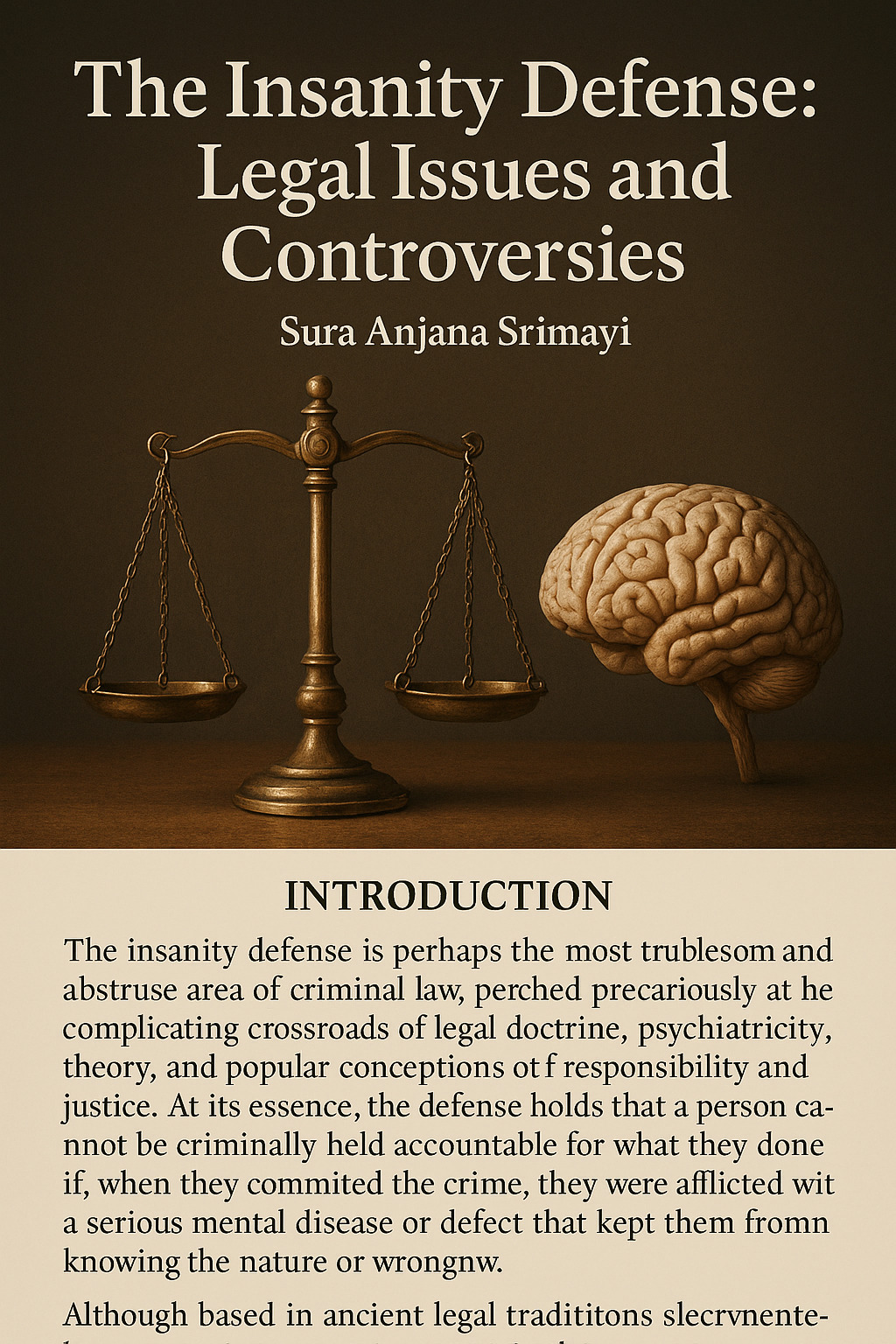View News
The-Insanity-Defense-Legal-Issues-and-Controversies

The Insanity Defense: Legal Issues and Controversies
~Sura Anjana Srimayi
INTRODUCTION
The insanity defense is perhaps the most troublesome and abstruse area of criminal law, perched precariously at the complicating crossroads of legal doctrine, psychiatric theory, and popular conceptions of responsibility and justice. At its essence, the defense holds that a person cannot be criminally held accountable for what they have done if, when they committed the crime, they were afflicted with a serious mental disease or defect that kept them from knowing the nature of the acts or that their acts were wrong. Although based in ancient legal traditions that made a distinction between sane and insane criminals, its use in contemporary jurisprudence is extremely contentious.
I. Historical Roots and Evolution of the Insanity Defense
The idea that mental illness could reduce criminal culpability is old. Early legal systems understood that those who were not of sound mind or understanding would not make good subjects for punishment.
A. Early English Common Law
In early English common law, the "wild beast" test was an early attempt at formulating criminal insanity. This test implied that a defendant would be considered insane if they were so without reason that they did not know what they were doing anymore than a wild beast. This primitive test emphasized a basic principle: criminal responsibility requires a certain amount of mental capacity.
B. The M'Naghten Rules (1843)
The most significant and lasting legal standard of insanity came from the M'Naghten case in England in 1843. Daniel M'Naghten, who had paranoid delusions, tried to kill the Prime Minister but ended up shooting his secretary. His acquittal outraged the public, and the M'Naghten Rules were formulated. These regulations provide that in order to set up a defense on grounds of insanity, it must be clearly established that, at the time of committing the act, the party accused was suffering from such defect of reason, resulting from disease of the mind, as not to know the nature and quality of the act he was committing; or, if he knew it, that he did not know that he was doing what was wrong. The M'Naghten Rules focus on cognitive ability – the capacity to know and reason.
II. Contemporary Legal Criteria of Insanity
A. The Irresistible Impulse Test
Appreciating the shortcomings of M'Naghten, which only considers cognitive ability, some jurisdictions embraced the "irresistible impulse" test. This rule contends that a defendant can be determined to be insane even if they understood their action was wrong, but were compelled by an irresistible impulse because of a mental defect or disease that they could not suppress. This test reflects the volitional component of conduct, in that it is possible for a person to know right from wrong but lack control over their own actions.
B. The Durham Rule (Product Test)
Emerged in the American jurisdiction of Durham v. United States (1954), this rule provided that an accused is not criminally responsible if his criminal act was the result of mental disease or mental defect. This rule was much more extensive than M'Naghten or irresistible impulse, emphasizing a causal relationship between the mental condition and the criminal act. But its imprecision and the specter of enabling too many defendants to go free led to its eventual rejection in most states.
C. The ALI (American Law Institute) Model Penal Code Test
The ALI's Model Penal Code test, developed in 1962, is a middle ground between the cognitive emphasis of M'Naghten and the volitional emphasis of irresistible impulse. It provides that an individual is not responsible for criminal behavior if at the time of such behavior due to mental disease or defect, he is lacking substantial capacity either to appreciate the criminality (wrongfulness) of his act or to conform his act to requirements of law. This test substituted the "totally incapacitating" requirement of M'Naghten with "lacks substantial capacity" and specifically added a volitional element. It became the most widely adopted test in the United States.
D. The Post-Hinckley Shift: Guilty But Mentally Ill
The presidential attempted assassination of Ronald Reagan by John Hinckley Jr. in 1981 and his acquittal by reason of insanity using the ALI test ignited sharp public debate. This led to broad reform across the United States, as most states and the federal system made it more difficult to establish the insanity defense.
- Shifting the Burden of Proof: The burden to establish insanity frequently shifted to the defense (to establish insanity) from the prosecution (to establish sanity), typically by clear and convincing evidence, or even beyond a reasonable doubt in a few states.
- Return to a Stricter M'Naghten-like Standard: Most jurisdictions dropped the volitional prong of the ALI test, returning to a stricter cognitive-oriented standard akin to M'Naghten.
- Development of "Guilty But Mentally Ill" (GBMI) Verdict: Numerous states implemented the GBMI verdict, permitting juries to return a verdict of guilty but mentally ill. This verdict generally results in the defendant receiving psychiatric treatment while they are in jail, but contrary to an acquittal based on insanity, they are still held criminally liable and receive a sentence.
III. Controversies Arising from the Insanity Defense
A. Public Perception and Misconceptions
One of the main controversies comes from public misconception. The defense is sometimes viewed as a "get out of jail free card" for troublesome criminals to avoid punishment. In practice, the insanity defense is seldom invoked and even less often successful. Research demonstrates it is raised in fewer than 1% of felony cases and is effective in but a small fraction of these. When effective, defendants are usually sent to mental institutions, sometimes for more time than they would otherwise have spent behind bars.
B. Defining "Mental Disease or Defect"
The legal definition of "mental disease or defect" is frequently distinct from psychiatric definitions, causing conflict between lawyers and physicians. Courts usually have difficulty in establishing the dividing line between a treatable mental illness and one serious enough to eliminate criminal responsibility. Personality disorders, for example, are usually not worthy of an insanity defense.
C. The Role of Expert Testimony
Psychiatrists and psychologists are also important expert witnesses in cases involving the insanity defense. Their testimony, however, is often complicated, contradictory, and even seen as subjective. There are fears of "hired guns" whose testifying opinions are congruent with the party that hired them, and that it is impossible for juries (made up of laypeople) to completely understand complicated psychiatric ideas.
D. The "Moral" Question of Culpability
Outside the legal definitions, the insanity defense reaches into deeply held moral and philosophical conceptions of free will, personal responsibility, and retribution. Society struggles with whether it is fair to punish an individual who actually did not have the ability to choose otherwise, even though his or her conduct harmed others.
E. Fear for Public Safety
A major concern, particularly following high-profile cases, is the perceived danger to public safety in releasing individuals found not guilty by reason of insanity from institutions. While stringent review processes are generally in place for release, the underlying fear of repeated violence often drives demands for higher insanity standards or abolition of the defense.
IV. Implications and Future Directions
A. Treatment vs. Punishment
The essence of the insanity defense is that those who are not morally blameworthy because of mental illness should be treated, not punished. When an insanity defense is successful, the defendant is committed to a psychiatric institution, with an emphasis on rehabilitation and stabilization of the defendant's mental condition.
B. Deterrence
Critics contend that the insanity defense removes the deterrent value of criminal law, as it implies that some people may not be exposed to the full extent of their punishment. People who support the insanity defense, however, posit that real deterrence depends on whether people are able to engage in rational thought and are aware of what they are doing.
C. Resource Allocation
The evaluation, treatment, and post-trial disposition of persons found not guilty by reason of insanity necessitate extensive mental health resources. The debates tend to center on whether the resources are adequate and how well the criminal justice system and mental health facilities coordinate.
D. Therapeutic Jurisprudence
The nuances of the insanity defense have fueled the interest in therapeutic jurisprudence, a discipline that is concerned with the effects of legal rules, procedures, and lawyer roles on the mental and physical well-being of participants in the legal system. It attempts to incorporate therapeutic thinking into legal proceedings.
E. Ongoing Reforms and Debates
The insanity defense debate is not about to end. Jurisdictions continually revise and tighten their standards, frequently due to pressure from the community or changed psychiatric insight. The trend since the 1980s has tended to narrow the defense, but the underlying ethical and legal issues it raises persist. The contribution of neuroscience and higher-level brain imaging to knowledge of mental states during the commission of a crime also raises an emerging frontier for this defense.
CONCLUSION
The insanity defense is an extreme ethical and legal dilemma, forcing societies to balance the need for public safety with commitments to individual responsibility and concern for those afflicted with extreme mental illness. From the original M'Naghten Rules to the contemporary extensions and the "Guilty But Mentally Ill" finding, legal systems have struggled worldwide with the challenging task of delineating criminal culpability in cases involving impaired mental states. Although debates continue to surround its usage, popular opinion, and the use of expert witnesses, the underlying assumption behind the insanity defense—that justice is served through separating offenders with a culpable mind from those without one as a result of extreme mental incapacitation—continues to be an integral principle of most contemporary legal systems. The constant development of psychiatric thought and social mores will certainly continue to influence the future direction of this intricate and vitally significant legal principle.
"Unlock the Potential of Legal Expertise with LegalMantra.net - Your Trusted Legal Consultancy Partner”
Disclaimer: Every effort has been made to avoid errors or omissions in this material in spite of this, errors may creep in. Any mistake, error or discrepancy noted may be brought to our notice which shall be taken care of in the next edition In no event the author shall be liable for any direct indirect, special or incidental damage resulting from or arising out of or in connection with the use of this information Many sources have been considered including Newspapers, Journals, Bare Acts, Case Materials , Charted Secretary, Research Papers etc

